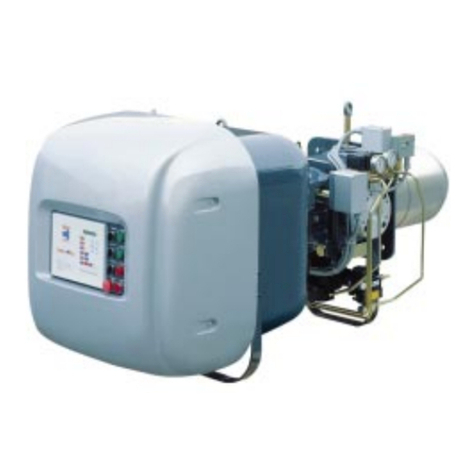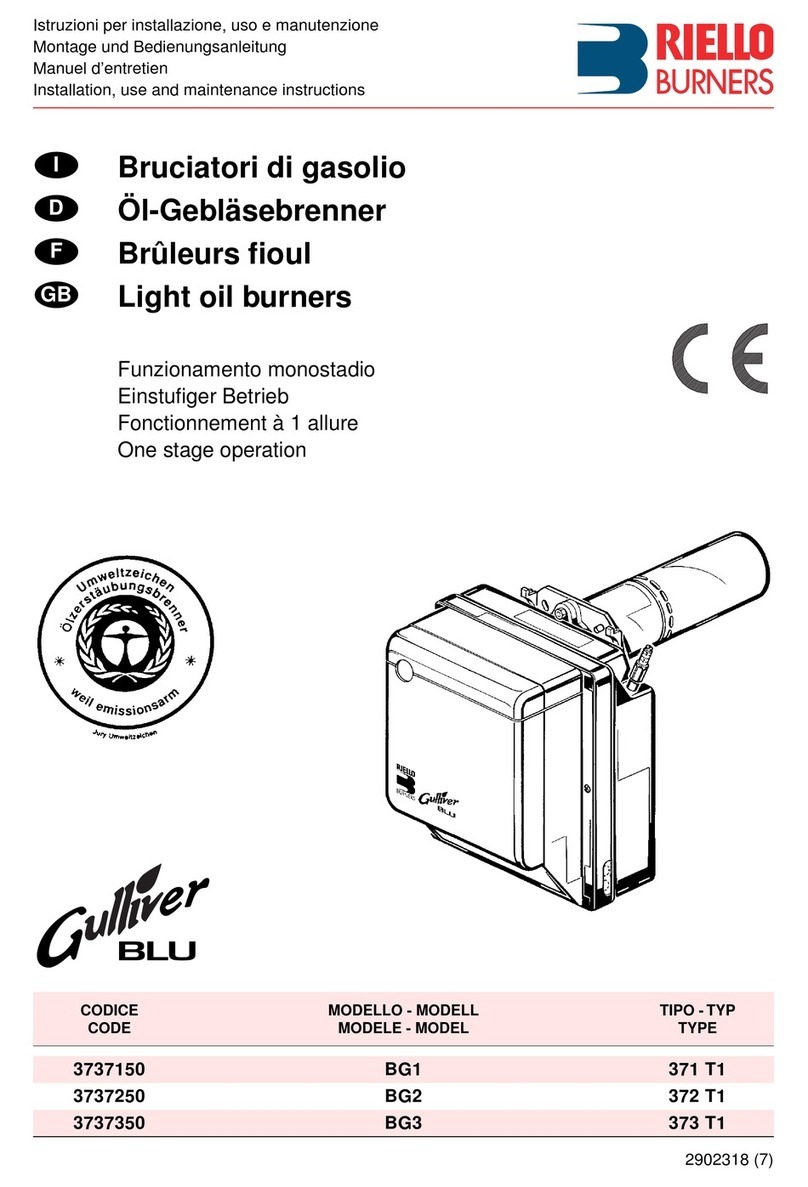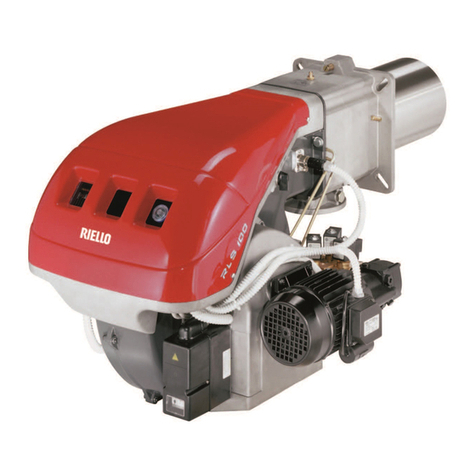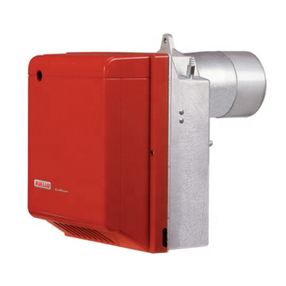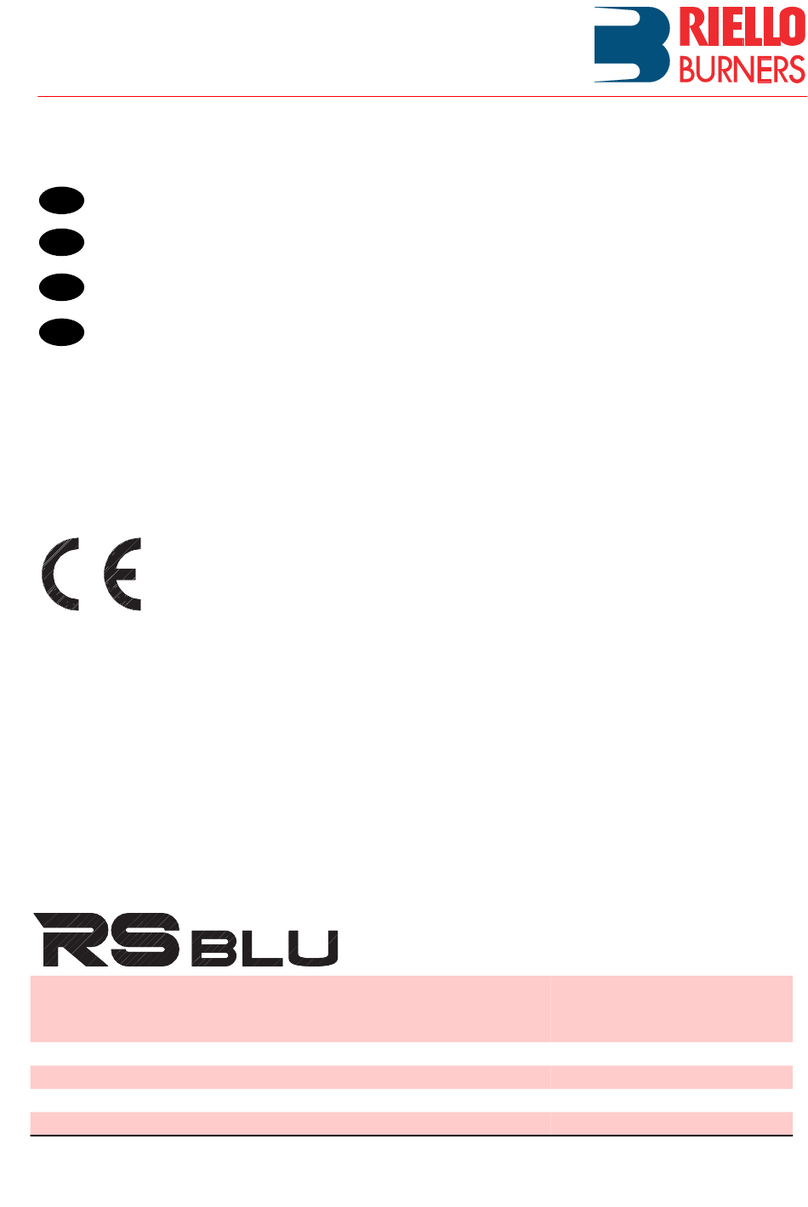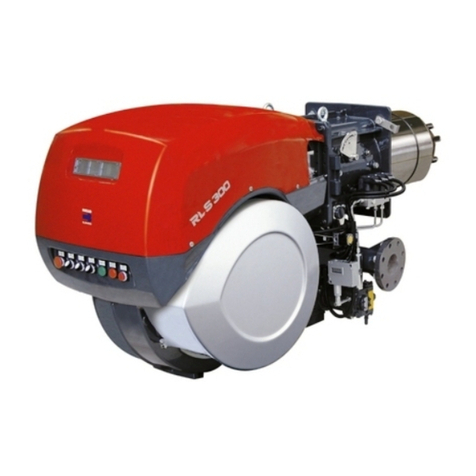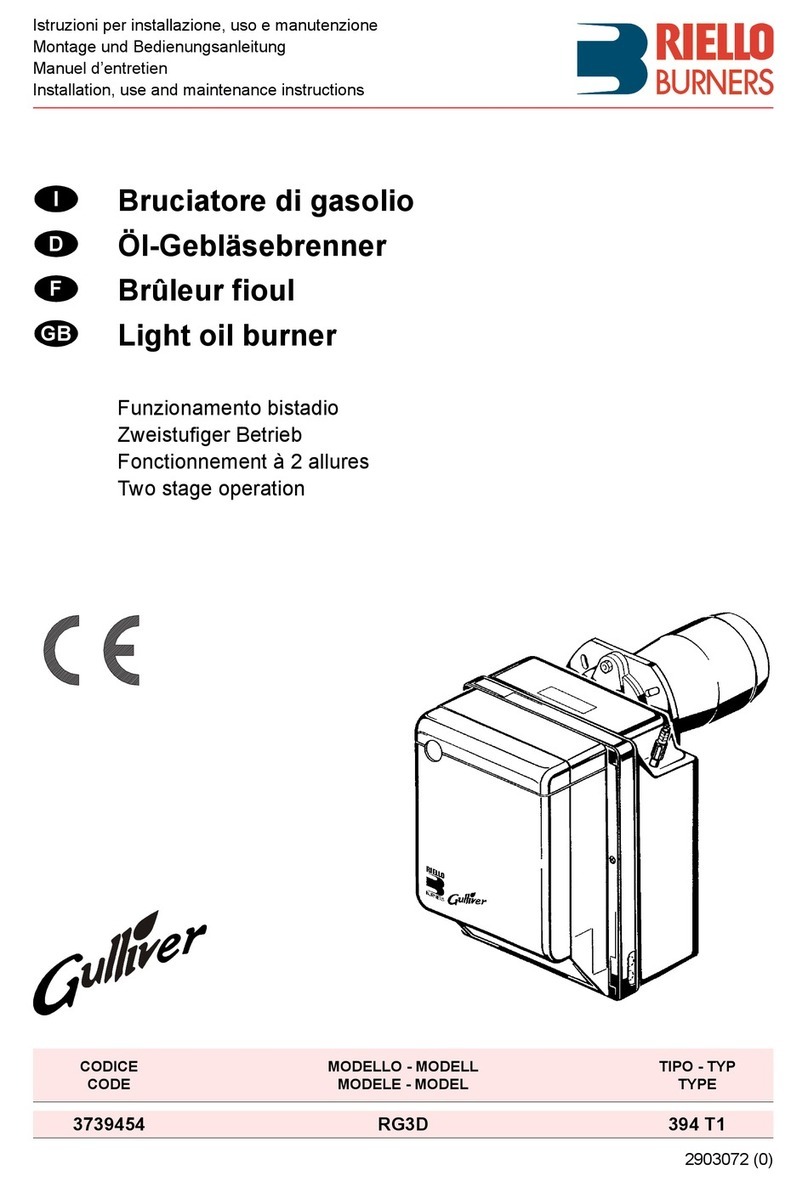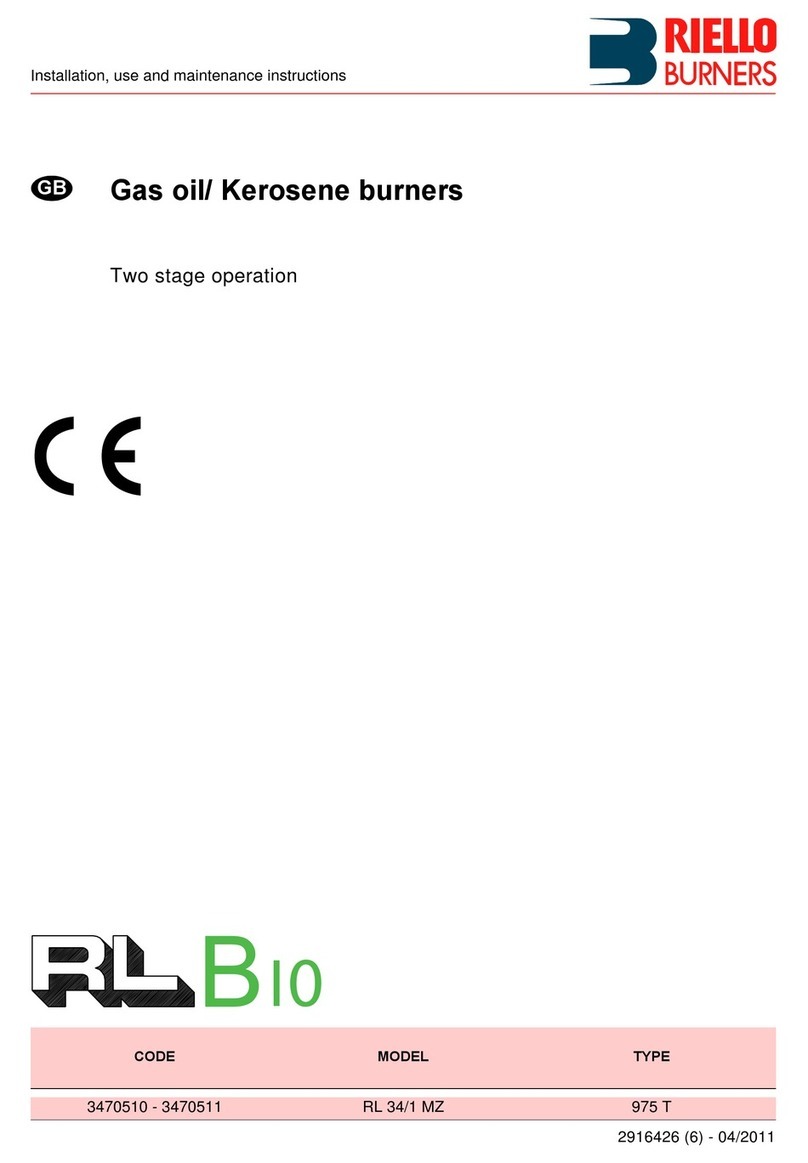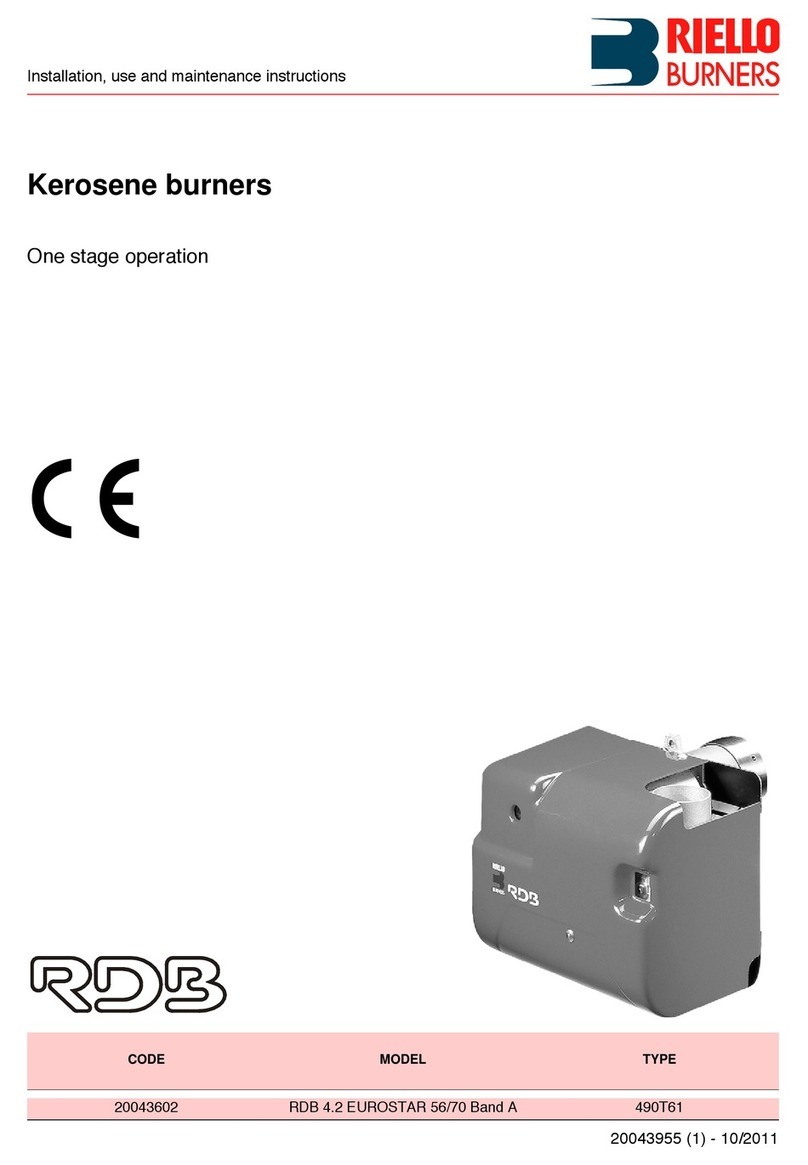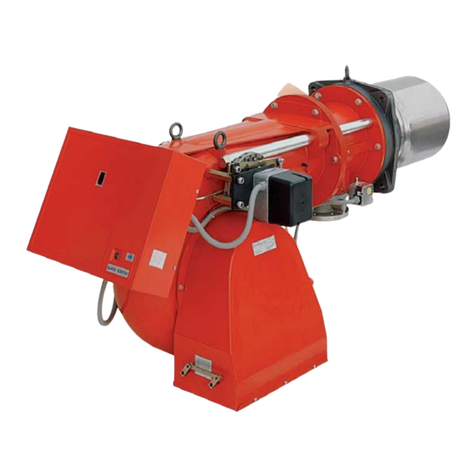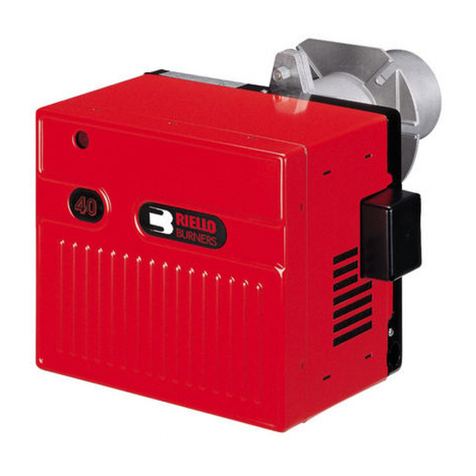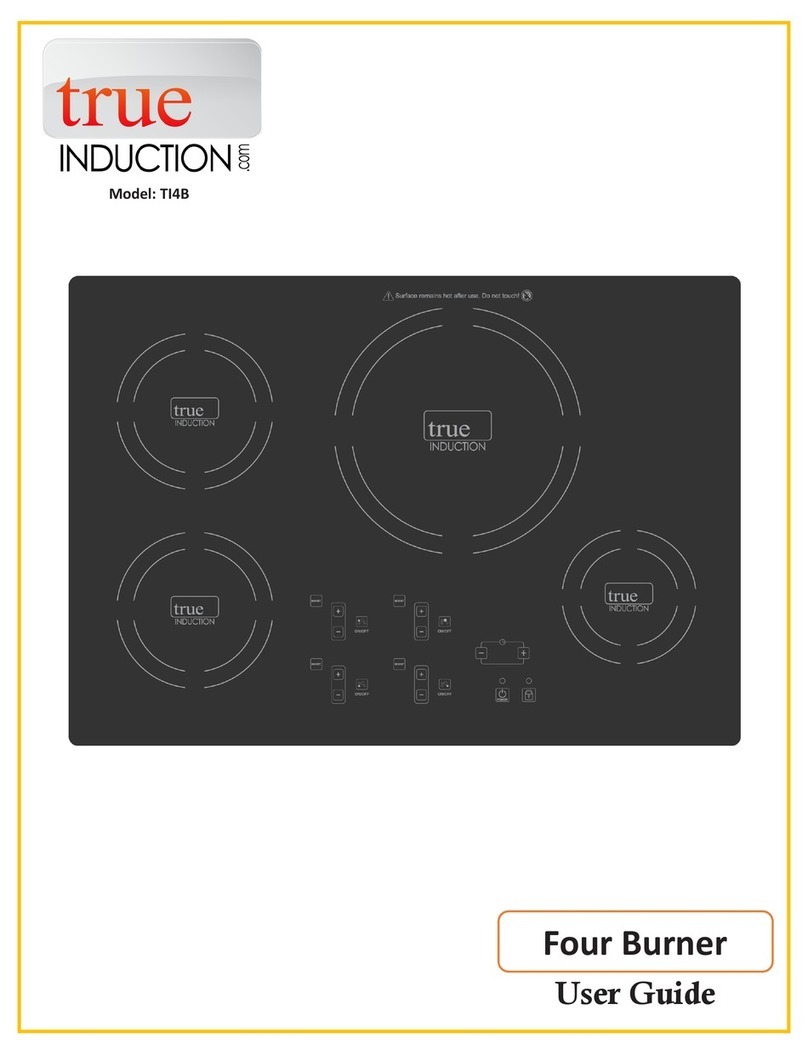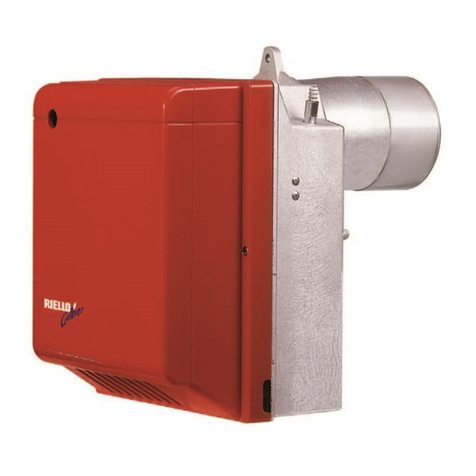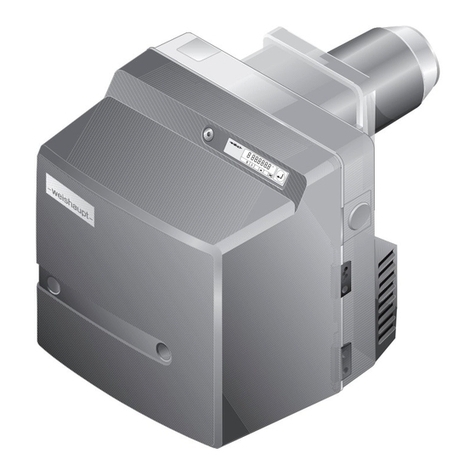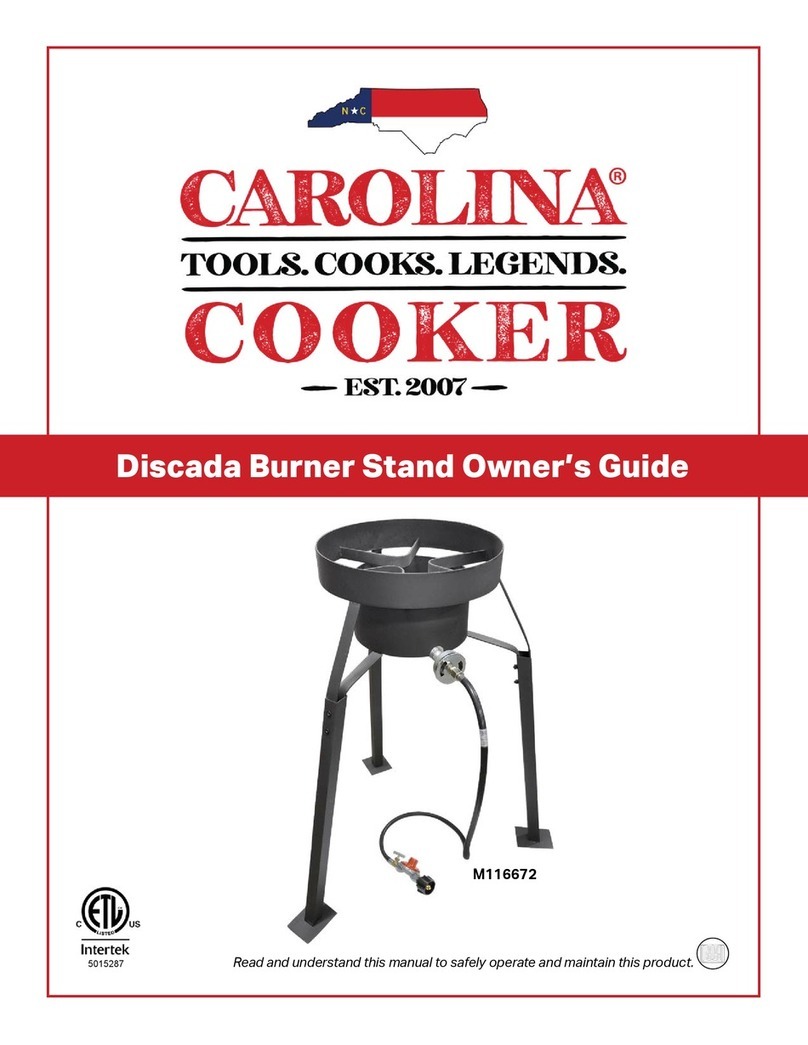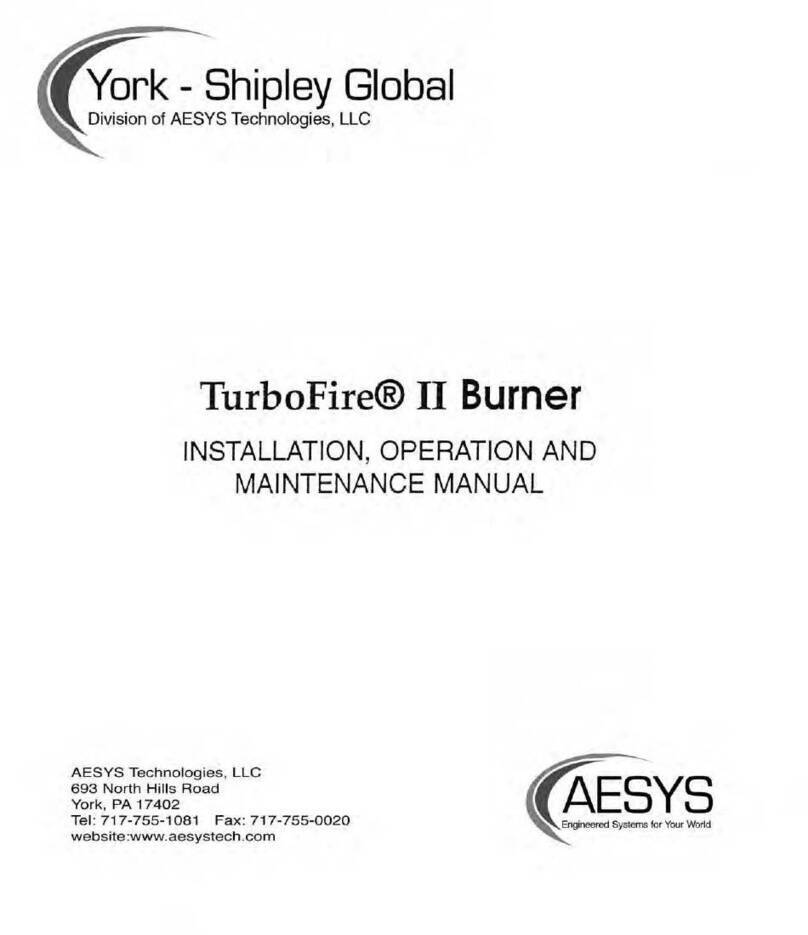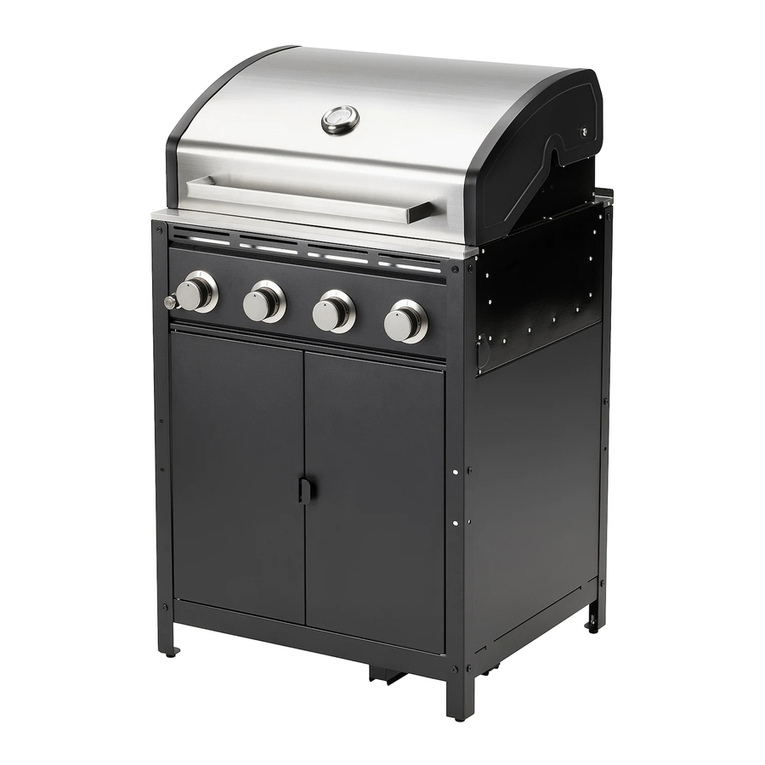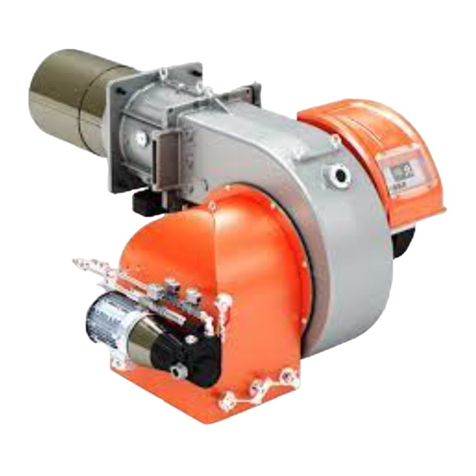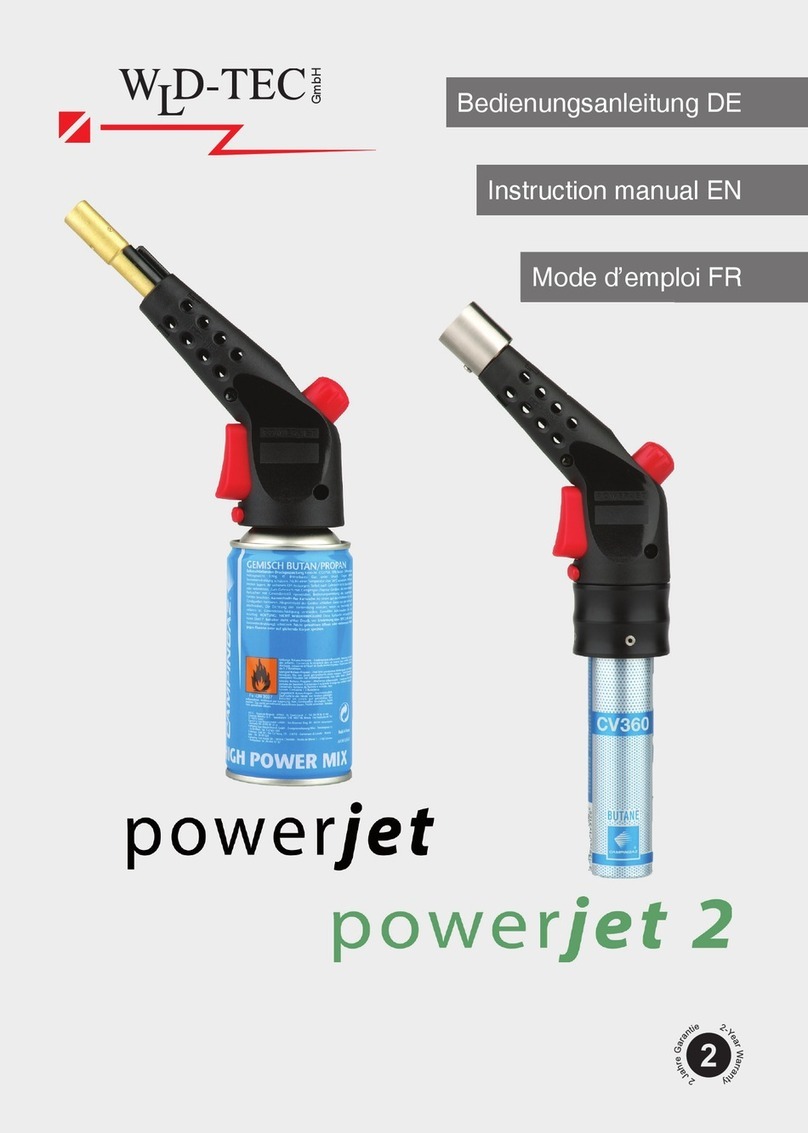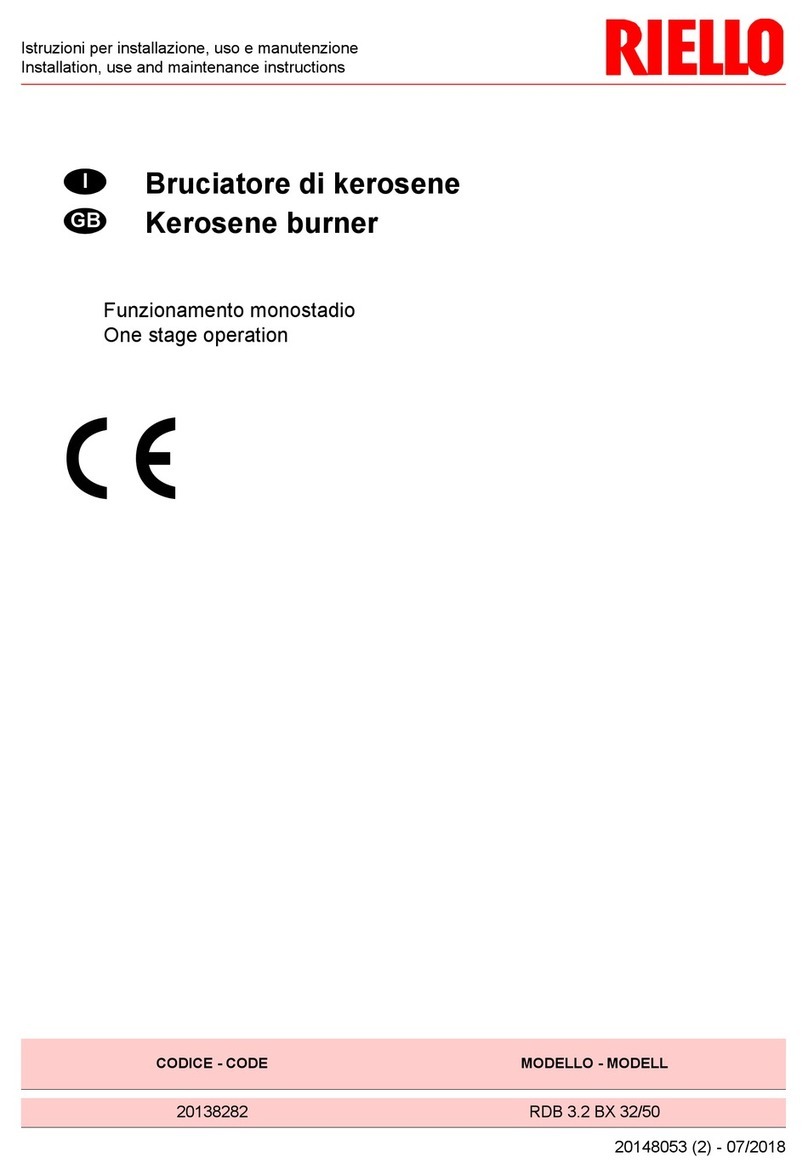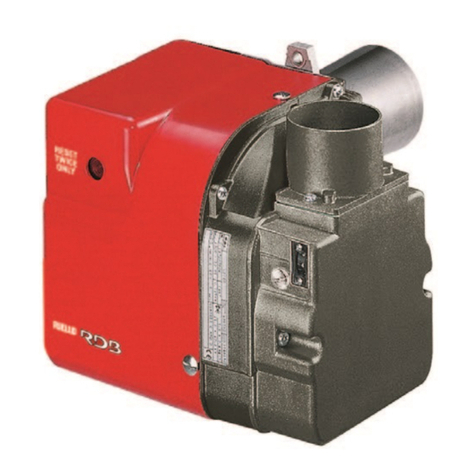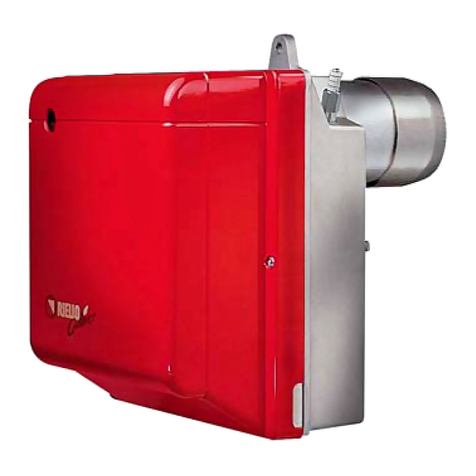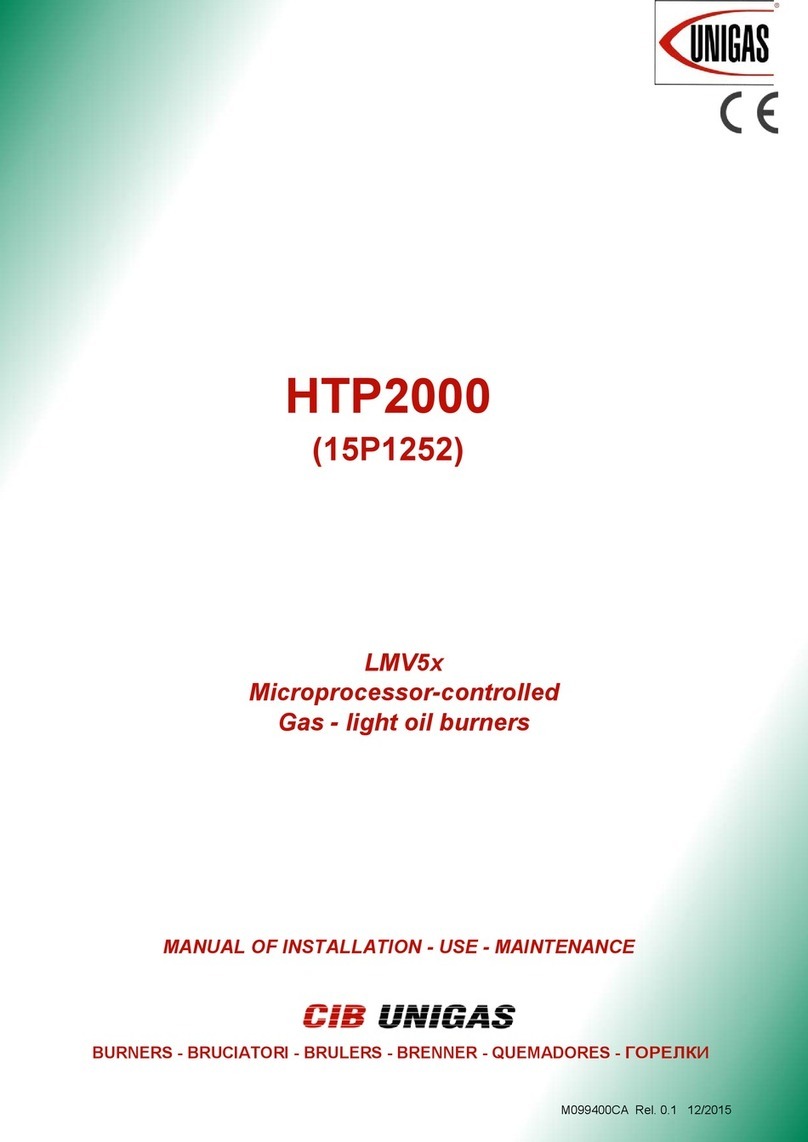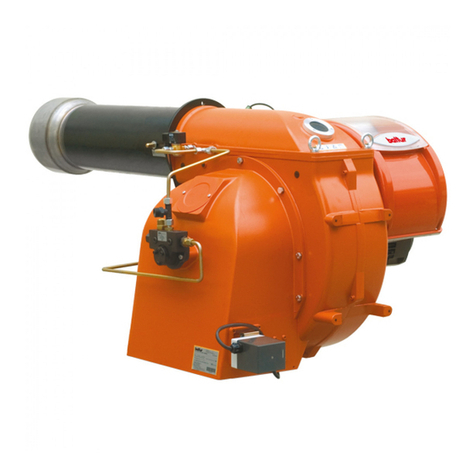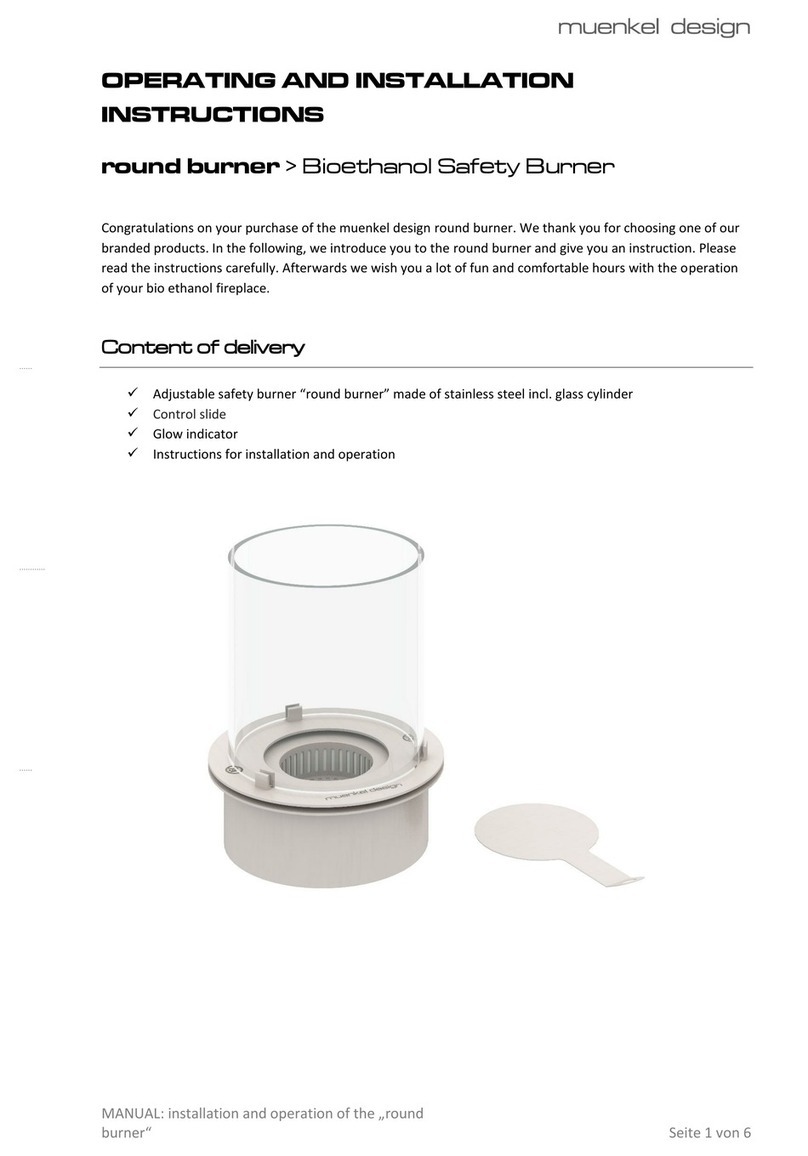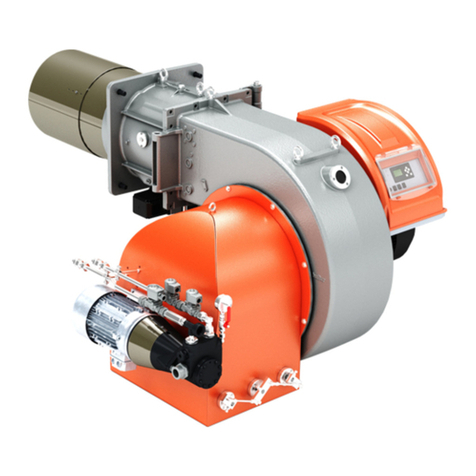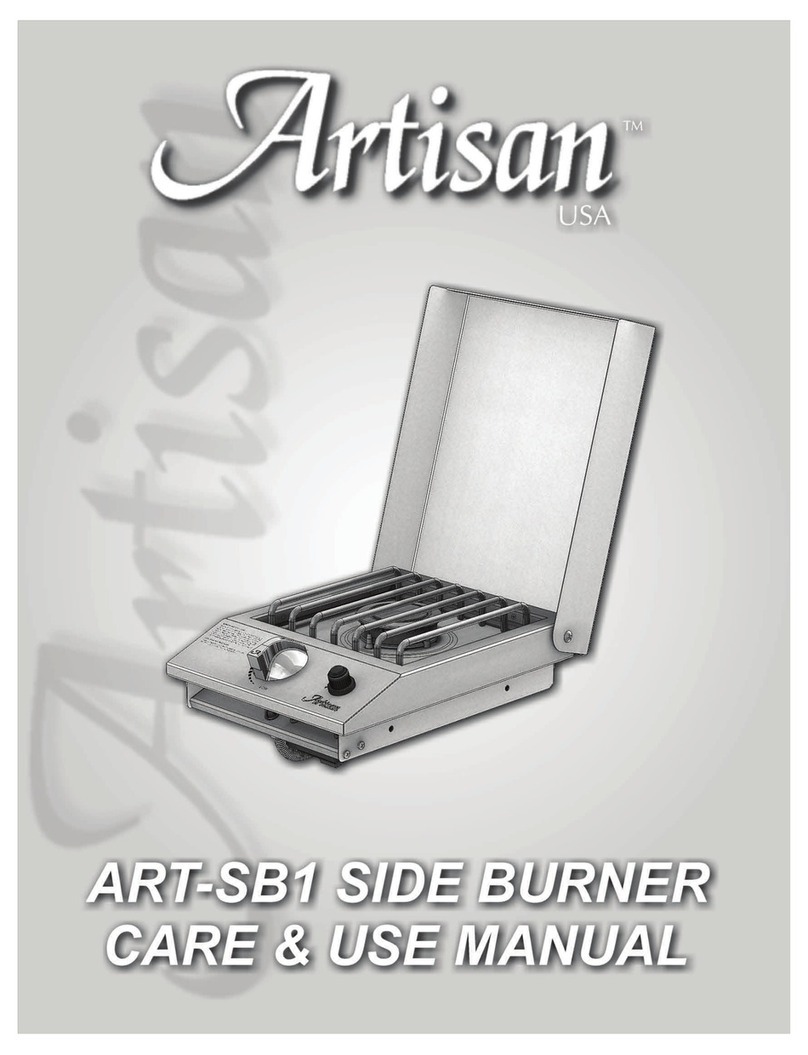
3
INDICE
DATI TECNICI . . . . . . . . . . . . . . . . . . . . . . . . . . . . . . . . . pagina 4
Versioni costruttive . . . . . . . . . . . . . . . . . . . . . . . . . . . . . . . . . . . . 4
Accessori . . . . . . . . . . . . . . . . . . . . . . . . . . . . . . . . . . . . . . . . . . . 4
Descrizione bruciatore . . . . . . . . . . . . . . . . . . . . . . . . . . . . . . . . . 8
Imballo - Peso . . . . . . . . . . . . . . . . . . . . . . . . . . . . . . . . . . . . . . . 8
Ingombro . . . . . . . . . . . . . . . . . . . . . . . . . . . . . . . . . . . . . . . . . . . 8
Corredo . . . . . . . . . . . . . . . . . . . . . . . . . . . . . . . . . . . . . . . . . . . . 8
Campo di lavoro . . . . . . . . . . . . . . . . . . . . . . . . . . . . . . . . . . . . . 10
Caldaia di prova . . . . . . . . . . . . . . . . . . . . . . . . . . . . . . . . . . . . . 10
Caldaie commerciali. . . . . . . . . . . . . . . . . . . . . . . . . . . . . . . . . . 10
Pressione gas. . . . . . . . . . . . . . . . . . . . . . . . . . . . . . . . . . . . . . . 12
INSTALLAZIONE. . . . . . . . . . . . . . . . . . . . . . . . . . . . . . . . . . . . 14
Piastra caldaia . . . . . . . . . . . . . . . . . . . . . . . . . . . . . . . . . . . . . . 14
Lunghezza boccaglio . . . . . . . . . . . . . . . . . . . . . . . . . . . . . . . . . 14
Fissaggio del bruciatore alla caldaia . . . . . . . . . . . . . . . . . . . . . 14
Regolazione testa di combustione . . . . . . . . . . . . . . . . . . . . . . . 16
Linea alimentazione gas. . . . . . . . . . . . . . . . . . . . . . . . . . . . . . . 18
Regolazioni prima dell»accensione . . . . . . . . . . . . . . . . . . . . . . . 20
Servomotore. . . . . . . . . . . . . . . . . . . . . . . . . . . . . . . . . . . . . . . . 20
Avviamento bruciatore . . . . . . . . . . . . . . . . . . . . . . . . . . . . . . . . 20
Accensione bruciatore . . . . . . . . . . . . . . . . . . . . . . . . . . . . . . . . 20
Regolazione bruciatore: . . . . . . . . . . . . . . . . . . . . . . . . . . . . . . . 22
1 - Potenza all»accensione . . . . . . . . . . . . . . . . . . . . . . . . . . . . . 22
2 - Potenza MAX . . . . . . . . . . . . . . . . . . . . . . . . . . . . . . . . . . . . 22
3 - Potenza MIN . . . . . . . . . . . . . . . . . . . . . . . . . . . . . . . . . . . . . 24
4 - Potenze intermedie . . . . . . . . . . . . . . . . . . . . . . . . . . . . . . . . 24
5 - Pressostato aria . . . . . . . . . . . . . . . . . . . . . . . . . . . . . . . . . . 26
6 - Pressostato gas di massima . . . . . . . . . . . . . . . . . . . . . . . . . 26
7 - Pressostato gas di minima . . . . . . . . . . . . . . . . . . . . . . . . . . 26
Controllo presenza fiamma . . . . . . . . . . . . . . . . . . . . . . . . . . . . 26
Funzionamento bruciatore . . . . . . . . . . . . . . . . . . . . . . . . . . . . . 28
Controlli finali . . . . . . . . . . . . . . . . . . . . . . . . . . . . . . . . . . . . . . . 30
Manutenzione. . . . . . . . . . . . . . . . . . . . . . . . . . . . . . . . . . . . . . . 30
Anomalie - Rimedi . . . . . . . . . . . . . . . . . . . . . . . . . . . . . . . . . . . 32
Normale funzionamento / Tempo di rilevazione fiamma . . . . . . 36
Appendice . . . . . . . . . . . . . . . . . . . . . . . . . . . . . . . . . . . . . . . . . 38
Collegamenti elettrici . . . . . . . . . . . . . . . . . . . . . . . . . . . . . . . . . 38
Schema quadro elettrico . . . . . . . . . . . . . . . . . . . . . . . . . . . . . . 38
Avvertenza
Le figure richiamate nel testo sono così indicate:
1)(A) =Particolare 1 della figura A nella stessa pagina del testo;
1)(A)p.8 =Particolare 1 della figura A riportata a pagina 8.
IINHALT
TECHNISCHE ANGABEN . . . . . . . . . . . . . . . . . . . . . . . . . Seite 5
Bauvarianten . . . . . . . . . . . . . . . . . . . . . . . . . . . . . . . . . . . . . . . . . 5
Zubehör. . . . . . . . . . . . . . . . . . . . . . . . . . . . . . . . . . . . . . . . . . . . . 5
Brennerbeschreibung . . . . . . . . . . . . . . . . . . . . . . . . . . . . . . . . . . 9
Verpackung - Gewicht. . . . . . . . . . . . . . . . . . . . . . . . . . . . . . . . . . 9
Abmessungen . . . . . . . . . . . . . . . . . . . . . . . . . . . . . . . . . . . . . . . . 9
Ausstattung . . . . . . . . . . . . . . . . . . . . . . . . . . . . . . . . . . . . . . . . . . 9
Regelbereich . . . . . . . . . . . . . . . . . . . . . . . . . . . . . . . . . . . . . . . . 11
Prüfkessel . . . . . . . . . . . . . . . . . . . . . . . . . . . . . . . . . . . . . . . . . . 11
Handelsübliche Kessel . . . . . . . . . . . . . . . . . . . . . . . . . . . . . . . . 11
Gasdruck. . . . . . . . . . . . . . . . . . . . . . . . . . . . . . . . . . . . . . . . . . . 13
INSTALLATION . . . . . . . . . . . . . . . . . . . . . . . . . . . . . . . . . . . . . 15
Kesselplatte. . . . . . . . . . . . . . . . . . . . . . . . . . . . . . . . . . . . . . . . . 15
Flammrohrlänge . . . . . . . . . . . . . . . . . . . . . . . . . . . . . . . . . . . . . 15
Befestigung des Brenners am Heizkessel . . . . . . . . . . . . . . . . . 15
Einstellung des Flammkopfs . . . . . . . . . . . . . . . . . . . . . . . . . . . . 17
Gaszuleitung . . . . . . . . . . . . . . . . . . . . . . . . . . . . . . . . . . . . . . . . 19
Einstellungen vor der Zündung . . . . . . . . . . . . . . . . . . . . . . . . . . 21
Stellantrieb . . . . . . . . . . . . . . . . . . . . . . . . . . . . . . . . . . . . . . . . . 21
Anfahren des Brenners . . . . . . . . . . . . . . . . . . . . . . . . . . . . . . . . 21
Zündung des Brenners . . . . . . . . . . . . . . . . . . . . . . . . . . . . . . . . 21
Brennereinstellung: . . . . . . . . . . . . . . . . . . . . . . . . . . . . . . . . . . . 23
1 - Zündleistung . . . . . . . . . . . . . . . . . . . . . . . . . . . . . . . . . . . . . 23
2 - Höchstleistung . . . . . . . . . . . . . . . . . . . . . . . . . . . . . . . . . . . . 23
3 - Mindestleistung . . . . . . . . . . . . . . . . . . . . . . . . . . . . . . . . . . . 25
4 - Zwischenleistungen . . . . . . . . . . . . . . . . . . . . . . . . . . . . . . . . 25
5 - Luft-Druckwächter . . . . . . . . . . . . . . . . . . . . . . . . . . . . . . . . . 27
6 - Gas-Höchstdruckwächter. . . . . . . . . . . . . . . . . . . . . . . . . . . . 27
7 - Gas-Mindestdruckwächter . . . . . . . . . . . . . . . . . . . . . . . . . . . 27
Flammenüberwachung . . . . . . . . . . . . . . . . . . . . . . . . . . . . . . . . 27
Brennerbetrieb . . . . . . . . . . . . . . . . . . . . . . . . . . . . . . . . . . . . . . 29
Endkontrollen . . . . . . . . . . . . . . . . . . . . . . . . . . . . . . . . . . . . . . . 30
Wartung. . . . . . . . . . . . . . . . . . . . . . . . . . . . . . . . . . . . . . . . . . . . 30
Störungen - Abhilfen . . . . . . . . . . . . . . . . . . . . . . . . . . . . . . . . . . 33
Normalbetrieb / Flammenfühlzeit . . . . . . . . . . . . . . . . . . . . . . . . 36
Anhang. . . . . . . . . . . . . . . . . . . . . . . . . . . . . . . . . . . . . . . . . . . . 38
Elektroanschlüsse . . . . . . . . . . . . . . . . . . . . . . . . . . . . . . . . . . . . 38
Schaltplan . . . . . . . . . . . . . . . . . . . . . . . . . . . . . . . . . . . . . . . . . . 38
Anmerkung
Die Zeichnungen, auf die im Text Bezug genommen wird, werden
folgendermaßen bezeichnet:
1)(A) =Detail 1 der Zeichnung A auf der gleichen Textseite;
1)(A)p.8 =Detail 1 der Zeichnung A auf Seite 8.
D
CONTENTS
TECHNICAL DATA . . . . . . . . . . . . . . . . . . . . . . . . . . . . . . page 6
Variants . . . . . . . . . . . . . . . . . . . . . . . . . . . . . . . . . . . . . . . . . . . . 6
Accessories . . . . . . . . . . . . . . . . . . . . . . . . . . . . . . . . . . . . . . . . . 6
Burner description . . . . . . . . . . . . . . . . . . . . . . . . . . . . . . . . . . . . 9
Packaging - Weight . . . . . . . . . . . . . . . . . . . . . . . . . . . . . . . . . . . 9
Max. dimensions . . . . . . . . . . . . . . . . . . . . . . . . . . . . . . . . . . . . . 9
Standard equipment. . . . . . . . . . . . . . . . . . . . . . . . . . . . . . . . . . . 9
Firing rate . . . . . . . . . . . . . . . . . . . . . . . . . . . . . . . . . . . . . . . . . . 11
Test boiler. . . . . . . . . . . . . . . . . . . . . . . . . . . . . . . . . . . . . . . . . . 11
Commercial boilers. . . . . . . . . . . . . . . . . . . . . . . . . . . . . . . . . . . 11
Gas pressure . . . . . . . . . . . . . . . . . . . . . . . . . . . . . . . . . . . . . . . 13
INSTALLATION . . . . . . . . . . . . . . . . . . . . . . . . . . . . . . . . . . . . . 15
Boiler plate . . . . . . . . . . . . . . . . . . . . . . . . . . . . . . . . . . . . . . . . . 15
Blast tube length . . . . . . . . . . . . . . . . . . . . . . . . . . . . . . . . . . . . 15
Securing the burner to the boiler . . . . . . . . . . . . . . . . . . . . . . . . 15
Combustion head setting . . . . . . . . . . . . . . . . . . . . . . . . . . . . . . 17
Gas line . . . . . . . . . . . . . . . . . . . . . . . . . . . . . . . . . . . . . . . . . . . 19
Adjustments before firing . . . . . . . . . . . . . . . . . . . . . . . . . . . . . . 21
Servomotor. . . . . . . . . . . . . . . . . . . . . . . . . . . . . . . . . . . . . . . . . 21
Burner starting . . . . . . . . . . . . . . . . . . . . . . . . . . . . . . . . . . . . . . 21
Burner firing . . . . . . . . . . . . . . . . . . . . . . . . . . . . . . . . . . . . . . . . 21
Burner calibration: . . . . . . . . . . . . . . . . . . . . . . . . . . . . . . . . . . . 23
1 - Firing output . . . . . . . . . . . . . . . . . . . . . . . . . . . . . . . . . . . . . 23
2 - MAX output . . . . . . . . . . . . . . . . . . . . . . . . . . . . . . . . . . . . . . 23
3 - MIN output. . . . . . . . . . . . . . . . . . . . . . . . . . . . . . . . . . . . . . . 25
4 - Intermediates outputs . . . . . . . . . . . . . . . . . . . . . . . . . . . . . . 25
5 - Air pressure switch . . . . . . . . . . . . . . . . . . . . . . . . . . . . . . . . 27
6 - Maximum gas pressure switch . . . . . . . . . . . . . . . . . . . . . . . 27
7 - Minimum gas pressure switch. . . . . . . . . . . . . . . . . . . . . . . . 27
Flame present check . . . . . . . . . . . . . . . . . . . . . . . . . . . . . . . . . 27
Burner operation. . . . . . . . . . . . . . . . . . . . . . . . . . . . . . . . . . . . . 29
Final checks . . . . . . . . . . . . . . . . . . . . . . . . . . . . . . . . . . . . . . . . 31
Maintenance. . . . . . . . . . . . . . . . . . . . . . . . . . . . . . . . . . . . . . . . 31
Faults - Suggested remedies . . . . . . . . . . . . . . . . . . . . . . . . . . . 34
Normal operation / Flame sensor timing . . . . . . . . . . . . . . . . . . 37
Appendix . . . . . . . . . . . . . . . . . . . . . . . . . . . . . . . . . . . . . . . . . . 38
Electrical connections. . . . . . . . . . . . . . . . . . . . . . . . . . . . . . . . . 38
Layout of electric panel board . . . . . . . . . . . . . . . . . . . . . . . . . . 38
N.B.
Figures mentioned in the text are identified as follows:
1)(A) =part 1 of figure A, same page as text;
1)(A)p.8 =part 1 of figure A, page number 8.
GB INDEX
DONNÉES TECHNIQUES . . . . . . . . . . . . . . . . . . . . . . . . . page 7
Modèles disponibles . . . . . . . . . . . . . . . . . . . . . . . . . . . . . . . . . . . 7
Accesoires. . . . . . . . . . . . . . . . . . . . . . . . . . . . . . . . . . . . . . . . . . . 7
Description brûleur . . . . . . . . . . . . . . . . . . . . . . . . . . . . . . . . . . . . 9
Emballage - Poids . . . . . . . . . . . . . . . . . . . . . . . . . . . . . . . . . . . . . 9
Encombrement . . . . . . . . . . . . . . . . . . . . . . . . . . . . . . . . . . . . . . . 9
Equipement standard . . . . . . . . . . . . . . . . . . . . . . . . . . . . . . . . . . 9
Plage de puissance. . . . . . . . . . . . . . . . . . . . . . . . . . . . . . . . . . . 11
Chaudière d»essai . . . . . . . . . . . . . . . . . . . . . . . . . . . . . . . . . . . . 11
Chaudières commerciales. . . . . . . . . . . . . . . . . . . . . . . . . . . . . . 11
Pression du gaz . . . . . . . . . . . . . . . . . . . . . . . . . . . . . . . . . . . . . 13
INSTALLATION . . . . . . . . . . . . . . . . . . . . . . . . . . . . . . . . . . . . . 15
Plaque chaudière . . . . . . . . . . . . . . . . . . . . . . . . . . . . . . . . . . . . 15
Longueur buse . . . . . . . . . . . . . . . . . . . . . . . . . . . . . . . . . . . . . . 15
Fixation du brûleur à la chaudière. . . . . . . . . . . . . . . . . . . . . . . . 15
Réglage tête de combustion . . . . . . . . . . . . . . . . . . . . . . . . . . . . 17
Ligne alimentation gaz . . . . . . . . . . . . . . . . . . . . . . . . . . . . . . . . 19
Réglages avant l»allumage . . . . . . . . . . . . . . . . . . . . . . . . . . . . . 21
Servomoteur . . . . . . . . . . . . . . . . . . . . . . . . . . . . . . . . . . . . . . . . 21
Démarrage brûleur . . . . . . . . . . . . . . . . . . . . . . . . . . . . . . . . . . . 21
Allumage brûleur . . . . . . . . . . . . . . . . . . . . . . . . . . . . . . . . . . . . . 21
Réglage brûleur: . . . . . . . . . . . . . . . . . . . . . . . . . . . . . . . . . . . . . 23
1 - Puissance à l»allumage . . . . . . . . . . . . . . . . . . . . . . . . . . . . . 23
2 - Puissance maximum . . . . . . . . . . . . . . . . . . . . . . . . . . . . . . . 23
3 - Puissance minimum. . . . . . . . . . . . . . . . . . . . . . . . . . . . . . . . 25
4 - Puissances intermédiares . . . . . . . . . . . . . . . . . . . . . . . . . . . 25
5 - Pressostat de l»air . . . . . . . . . . . . . . . . . . . . . . . . . . . . . . . . . 27
6 - Pressostat gaz seuil maximum . . . . . . . . . . . . . . . . . . . . . . . 27
7 - Pressostat gaz seuil minimum . . . . . . . . . . . . . . . . . . . . . . . . 27
Contrôle présence flamme . . . . . . . . . . . . . . . . . . . . . . . . . . . . . 27
Fonctionnement brûleur . . . . . . . . . . . . . . . . . . . . . . . . . . . . . . . 29
Contrôles finaux . . . . . . . . . . . . . . . . . . . . . . . . . . . . . . . . . . . . . 31
Entretien . . . . . . . . . . . . . . . . . . . . . . . . . . . . . . . . . . . . . . . . . . . 31
Anomalies/ Solutions. . . . . . . . . . . . . . . . . . . . . . . . . . . . . . . . . . 35
Fonctionnement normal/ Temps de révélation flamme . . . . . . . . 37
Annexe . . . . . . . . . . . . . . . . . . . . . . . . . . . . . . . . . . . . . . . . . . . . 38
Branchements électriques. . . . . . . . . . . . . . . . . . . . . . . . . . . . . . 38
Schéma tableau électrique . . . . . . . . . . . . . . . . . . . . . . . . . . . . . 38
Attention
Les figures rappelées dans le texte sont ainsi indiquées:
1)(A) =Détail 1 de la figure A dans la même page du texte;
1)(A)p.8 =Détail 1 de la figure A page 8.
F
